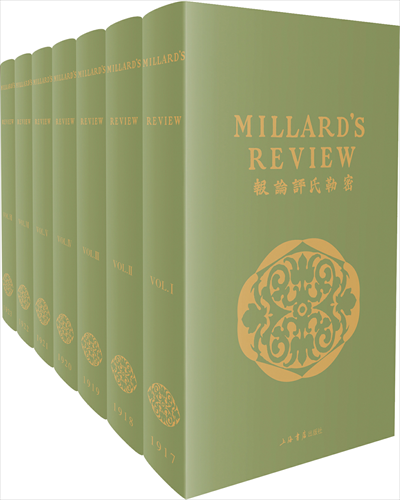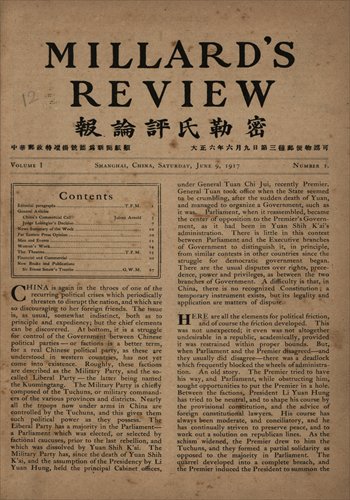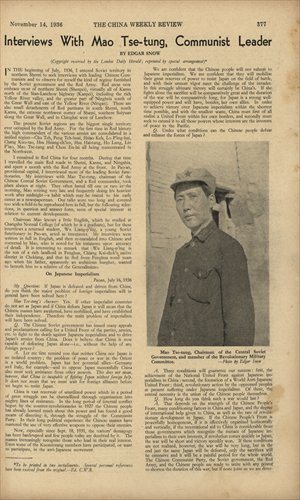Millard’s legacy

Volumes of reprinted Millard's Review

The initial issue of the weekly

One page of Mao's interview Photos: Courtesy of SH Bookstore Publishing House
On November 14, 1936, a photo was taken of Mao Zedong wearing an octagonal Red Army hat standing in front of a Yan'an cave. It appeared in the newspaper Millard's Review, an English-language weekly based in Shanghai from 1917 to 1953. The photo and accompanying interview written by American journalist Edgar Snow caused quite a stir.
At the time, the weekly's distribution destination included China and the US with its highest circulation reaching around 8,000 copies. It was also the first non-Chinese newspaper to release a portrait and interview of Mao Zedong.
"It is believed that almost all Americans and even many Chinese got their first sense of Mao Zedong as a person from Millard's Review," said Tang Xiaoyun, deputy director of Shanghai Bookstore Publishing House.
Recently, the publisher reissued photocopies of original editions of Millard's Review from 1917 to 1942. The new release comes in a 98-volume set, and can be ordered directly from the publisher for 80,000 yuan ($13,048).
First sense of Mao Zedong
Tang told the Global Times that because the newspaper was forced to close down temporarily by the Japanese military from 1942 to 1945, "The rest of the issues from 1945 to 1953 will also be republished by us in the near future." He said, nowadays, most of the original issues of Millard's Review are preserved in the Shanghai Library, and some other parts are kept in many university libraries in Shanghai. "We have also digitized all the original issues for permanent storage," Tang added.
Snow and his successor, Agnes Smedley, were probably the most well-known American journalists of World War II among Chinese people. But they were far from the only two American journalists to influence Americans with realities of China during the first half of the 20th century. Preceding them, Thomas F. Millard and John B. Powell could be regarded as the forerunners of American newsmen in modern China. They were the founder and the chief editor of Millard's Review.
Tang explained that it was no accident that those people (from Millard to Smedley) followed one another in coming to China at that time to work with Millard's Review. "All of them were actually from one place in the US, that is, the school of journalism based at the Columbia campus of the University of Missouri, and this school is joked as the 'Missouri Mafia,'" Tang said.
Missouri Mafia
Xing Jianrong, director of the Research and Compilation Department of Shanghai Municipal Archives, told the Global Times that the Missouri Mafia has always enjoyed a good reputation in the field of international journalism because of their objective and impartial attitude toward reporting.
This impartial nature was consistent in the reporting style of Millard's Review, "especially Powell," Xing said, "As a chief editor of Millard's Review who worked in China from 1922 to 1941, Powell wrote many articles about Japanese militarists' aggression against China at that time."
It was because of those articles Powell was put in jail by the Japanese military in December 1941 and was tortured in prison to the point that he was thereafter a cripple. He was sent back to America in 1942. After the conclusion of World War II, he attended the International Military Tribunal for the Far East as a witness during the trials of Japanese war criminals.
Xing was also the Chinese translator of Powell's memoir, My Twenty-Five Years in China, which was released in 2010. He told the Global Times that Powell was a journalist with a strong sense of social responsibility and was the first non-Chinese journalist in history to be terribly persecuted for his anti-Japanese aggression positions.
Millard's Review also reported the miserable social situation in China at that time, like the serious corruption inside the Kuomintang government. The newspaper also introduced Chinese celebrities and reported on the daily life of foreigners in China.
There was a regular column in Millard's Review called "Who's Who in China," which was devoted to introducing Chinese celebrities in different fields, including politics, the economy, military affairs, diplomacy and culture. Each introduction was accompanied by a portrait.
The precursor to that column was a series of articles written early in the paper's lifespan. From October 1922 to January 1923, the paper conducted a survey: "Who are the twelve greatest living Chinese?" It aroused great social response with more than 1,990 people participating in the vote, including newspaper subscribers and many others from different classes of society. Luminaries such as Sun Yat-sen, Hu Shi, Cai Yuanpei, Feng Yuxiang are all on the list.
As well as introducing the life story of those selected 12 people in the newspaper, Millard's Review also published the names of 195 people who got at least four votes, which covered people from all walks of life. Today, this list of names has become a very important document for researching China's history at that time.
Impact of American journalism
The British led the imperialist charge into China beginning in the mid-1800s, and they were in fact at the forefront in economics, politics and horse-racing in old Shanghai. Another influential English-language newspaper in Shanghai from 1850 to 1951 was the North China Daily News, founded by British merchant Henry Shearman.
But in Xing's opinion, the force of American journalism held a leading position and made a great impact on the later development of Chinese journalism since the early part of the 20th century in China.
"And the long-term special friendship between the Missouri Mafia and China continued after the founding of the People's Republic of China," Xing said.
In the end, it was the American government that in 1953 cut off Millard's Review's path to the US because of a report the paper wrote exposing American use of biological weapons during the Korean War.
Xiong Yuezhi, director of the Shanghai Historical Society, who is also a senior expert on researching the local history in Shanghai, believes that it is very necessary to preserve foreign-language newspapers that were once published in Shanghai, as they make excellent resources for studying contemporary history of Shanghai.
Xiong told the Global Times that, unlike many other cities in China, the long concession history in Shanghai determines the important historical value of any foreign-language documents, including newspapers and magazines that were based in the city.
"Special attention should be paid to all of them during the course of researching Shanghai's history," Xiong said.